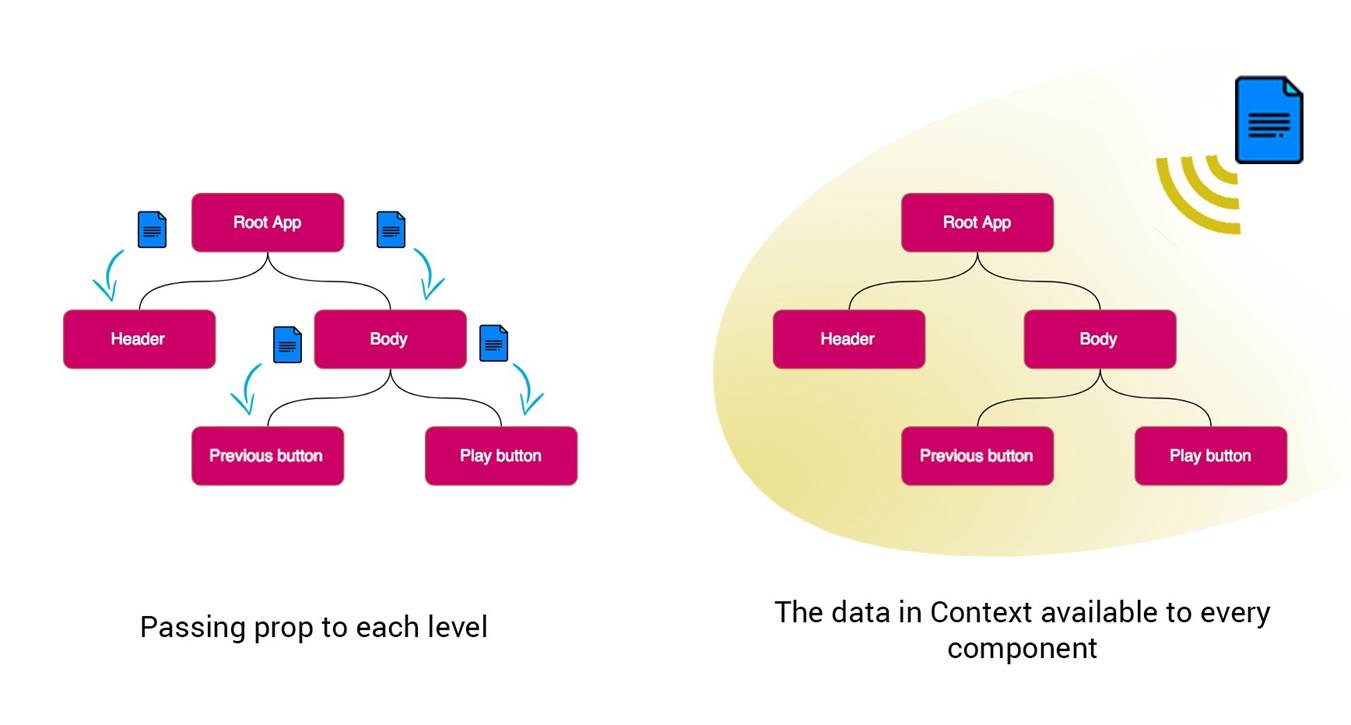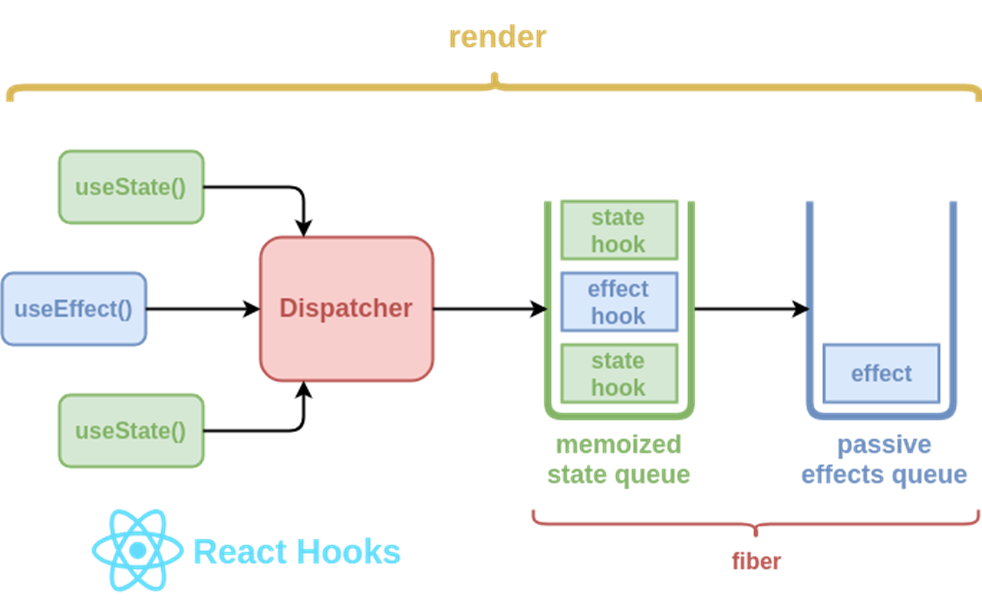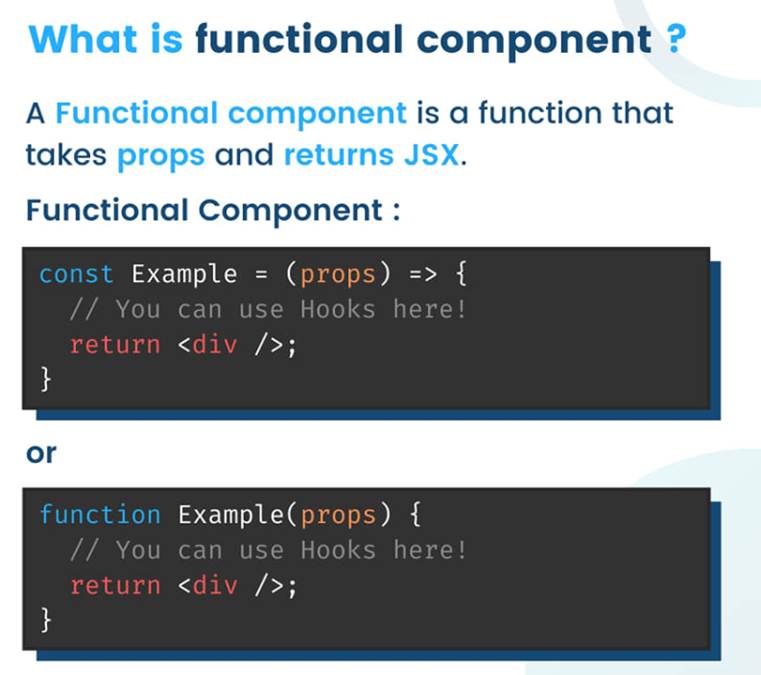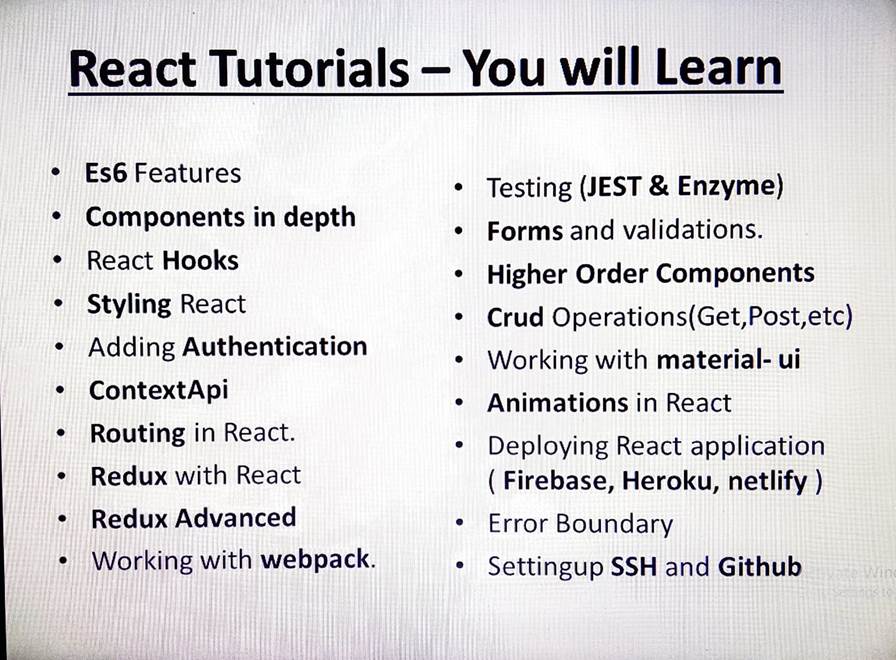|
Angular2 |
React |
||||||
|
Full MVC |
Handles View layer from MVC |
||||||
|
|
Server side rendering |
||||||
|
HTML/JS/CSS |
JSX |
||||||
|
|
|
||||||
|
View, Models, controllers |
All about components |
||||||
|
A lot to code |
Less to code* |
||||||
|
|
Virtual DOM concept |
||||||
|
|
React components are far more powerful than Angular templates; they should be compared with Angular’s directives instead. [Directives are Angular’s way of creating custom elements]. |
||||||
|
|
The virtual DOM used by React is simply an internal implementation detail of the framework which powers its amazing rendering performance. |
||||||
|
|
React keeps two copies of a virtual DOM (the original and updated versions). |
||||||
|
|
|

|
// JSX code
Writing React Components Using JSX and babel
<<script
|
Virtual DOM: In React, Virtual DOM exists which is like a lightweight copy of the actual DOM. So for every object that exists in the original DOM there is an object for that in React Virtual DOM. It is exactly the same, but it does not have the power to directly change the layout of the document. Manipulating DOM is slow, but manipulating Virtual DOM is fast as nothing gets drawn on the screen.
How Virtual DOM helps React?
Each time we change something in our JSX file, all the objects that are there
in the virtual DOM gets updated. Though it may sound that it is ineffective but
the cost is not much significant as updating the virtual DOM doesn’t take much
time. React maintains two Virtual DOM at each time, one contains the updated
Virtual DOM and one which is just the pre-update version of this updated
Virtual DOM. Now it compares the pre-update version with the updated Virtual
DOM and figures out what exactly has changed in the DOM. This process is known
as ‘diffing’. Once React finds out what exactly has changed then it updated
those objects only, on real DOM. This significantly improves the performance
and is the main reason why Virtual DOM is much loved by developers all around.
A Virtual DOM, used by React, is an in memory representation of the actual DOM. whereas the Shadow DOM is an HTML5 specification created to enable better composition of the DOM.
Shadow DOM
You include a third party stylesheet that includes some generic styling for table and now your calendar widgets are all broken - sounds familiar ? Congratulations - the future of the web platform has a solution for you : it is the Shadow DOM.
Shadow DOM was initially implemented by browser developers to implement encapsulated widgets like HTML 5 slider input element.
Components in React basically returns a piece of JSX code which tells what should be rendered on the screen. In React we mainly have two types of components:
1. Functional Components: Functional components are simply javascript functions. We can create a functional component in React by writing a javascript function. These functions may or may not receive data as parameters:
function Democomponent()
{
return <h1>Welcome Message!</h1>;
}
2. Class Components: The class components are little more complex than the functional components. The functional components are not aware about the other components in your program where as the class components can work with each other. We can pass data from one class component to other class component. We can use javascript ES6 classes to create class based components in React. Below example shows a valid class-based component in React:
class Democomponent extends React.Component
{
render(){
return <h1>Welcome Message!</h1>;
}
}
3 ways of sending props


defaultProps

Passing props from Parent to child

|
// Navbar Component function Navbar() { return <h1>This is Navbar.</h1> }
// Article list Component function ArticleList() { return <h1>This is Articles List.</h1> }
// App Component function App() { return ( <div> <Navbar /> <ArticleList /> </div> ) }
ReactDOM.render(<App />, document.getElementById('root')) |
PropTypes
|
// Component class PropTypesExample extends React.Component { render() { return ( <div> {/* printing all props */} <h1> {this.props.arrayProp} <br />
{this.props.stringProp} <br />
{this.props.numberProp} <br />
{this.props.boolProp} <br /> </h1> </div> ) } }
// validating prop types PropTypesExample.propTypes = { arrayProp: PropTypes.array, stringProp: PropTypes.string, numberProp: PropTypes.number, boolProp: PropTypes.bool, }
// creating default props PropTypesExample.defaultProps = { arrayProp: ['Ram', 'Shyam', 'Raghav'], stringProp: 'GeeksforGeeks', numberProp: 10, boolProp: true, }
export default PropTypesExample
|
ReactJS | Refs
Nice font from the url https://flaviocopes.com/react-ref-element/

|
<form ref={el => (this.form = el)}>
// without refs export default class WithoutRefs extends React.Component { constructor() { super() this.state = { sayings: '' } } update(e) { this.setState({ sayings: e.target.value }) } render() { return ( <div> Mukul Says <input type='text' onChange={this.update.bind(this)} /> <br /> <em>{this.state.sayings}</em> </div> ) } }
|
When to use refs
· Helpful when using third party libraries.
· Helpful in animations.
When not to use refs
· Should not be used with functional components because they dont have instances.
|
// using refs export default class WithRefs extends React.Component { constructor() { super() this.state = { sayings: '' } } update() { this.setState({ sayings: this.refs.anything.value }) } render() { return ( <div> Mukul Says <input type='text' ref='anything' onChange={this.update.bind(this)} /> <br /> <em>{this.state.sayings}</em> </div> ) } }
// using callback refs export default class CallbackRefs extends React.Component { constructor() { super() this.state = { sayings: '' } } update() { this.setState({ sayings: this.textbox.value }) } render() { return ( <div> Mukul Says{' '} <input type='text' ref={e => { this.textbox = e }} onChange={this.update.bind(this)} /> <br /> <em>{this.state.sayings}</em> </div> ) } }
// using without bind export default class WithoutBind extends React.Component { constructor() { super() this.state = { sayings: '' } } update = () => { this.setState({ sayings: this.textbox.value }) } render() { return ( <div> Mukul Says{' '} <input type='text' ref={e => { this.textbox = e }} onChange={this.update} /> <br /> <em>{this.state.sayings}</em> </div> ) } }
|





Typical Ajax in reactjs
|
class MyComponent extends React.Component { constructor(props) { super(props) this.state = { error: null, isLoaded: false, items: [], } }
componentDidMount() { fetch('https://api.example.com/items') .then(res => res.json()) .then( result => { this.setState({ isLoaded: true, items: result.items, }) }, // Note: it's important to handle errors here // instead of a catch() block so that we don't swallow // exceptions from actual bugs in components. error => { this.setState({ isLoaded: true, error, }) }, ) }
render() { const { error, isLoaded, items } = this.state if (error) { return <div>Error: {error.message}</div> } else if (!isLoaded) { return <div>Loading...</div> } else { return ( <ul> {items.map(item => ( <li key={item.name}> {item.name} {item.price} </li> ))} </ul> ) } } }
jQuery.get in reactjs
import React from 'react';
export default React.createClass({ ... componentDidMount() { $.get('your/url/here').done((loadedData) => { this.setState({data: loadedData}); }); ... }
|
No, Babel and Webpack is not necessary for React stack. You can still find other alternatives to build your favourite stack such as Browserify and Gulp.
However, if you want to make things easier, I do recommend you learn and use Babel and Webpack together with React because:
· You can use modules.
· You can use JSX with ES6.
· It support a lot of browsers
· You can use more advanced features (async/await) etc
With webpack
· You can use different loaders for sass, less, postcss etc
· You can use different plugins to optimise your build such as Uglify, HotModuleReplacement, Chunks etc























https://gist.github.com/UstatleenKaur/09356f326fb008a799b6800981906bdc
|
// UserContext.js
import React from 'react';
const UserContext = React.createContext({}); // here we can initialise with any value we want.
export const UserProvider = UserContext.Provider; export const UserConsumer = UserContext.Consumer; export default UserContext;
// App.js
import React from 'react'; import { UserProvider } from './UserContext'
const App = props => { const user = { name: 'Ustat', age: 24 };
return ( <UserProvider value={user}> <div> This is App Component </div> </UserProvider> ) }
export default App;
// Providing context for both class and functional components is the same. // However, consuming the context is slightly different for both cases.
// OrderInfo
import React from 'react'; import { UserConsumer } from './UserContext';
class OrderInfo extends React.Component { static contextType = UserContext;
componentDidMount() { let user = this.context; console.log(user); // { name: 'Ustat', age: 24 } }
render() {
// use this if you are retrieving value using contextType. let user = this.context;
return ( <div>{user.name}</div> )
OR
// use this if you wish to use UserConsumer return ( <UserConsumer> {context => { return <div>{context.name}</div> }} </UserConsumer> ) } }
// HomePage.js
import React, { useContext } from 'react'; import UserContext from './UserContext';
const HomePage = () => { const user = useContext(UserContext);
console.log(user); // { name: 'Ustat', age: 24 }
return null; }
|


Main API
Step 1: Initialise context
const Context = React.createContext();
Step 2: Expose it via Context.Provide
class TodoProvider extends React.Component {
state = {todos: [...]};
render() {
return (
<Context.Provider value={this.state.todos}>
{this.props.children}
</Context.Provider>
);
}
}
Step 3: Consume it via Context.Consumer
class TodoList extends React.Component {
render() {
return (
<Context.Consumer>
{todos => ....}
</Context.Consumer>
);
}
}
That’s it!




Pure Components in React are the
components which do not re-renders when the value of state and props has been
updated with the same values.
Features of React Pure Components
· Prevents re-rendering of Component if props or state is the same
· Takes care of “shouldComponentUpdate” implicitly
· State and Props are Shallow Compared
· Pure Components are more performant in certain cases


